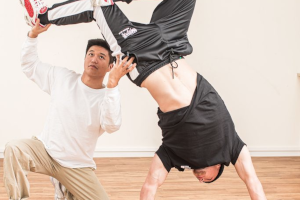Dance, with its explosive movements, powerful leaps, and vibrant energy, is more than just a passion for many female dancers—it’s a lifestyle. Styles like hip hop, breaking, locking, popping, krump, house, and electro push the body to its limits, demanding precision, control, and stamina. However, the intense physical demands these forms place on the body can lead to a lesser-talked-about consequence: pelvic floor strain. Despite its crucial role in a dancer’s physical well-being, the pelvic floor is often overlooked. In reality, these deep muscles can face significant challenges in dancers, impacting everything from movement flow to overall health and comfort.
Why Is the Pelvic Floor Important?
The pelvic floor is a group of muscles that support vital organs like the bladder, uterus, and rectum. It plays a key role in maintaining core stability, bladder control, sexual health, and even respiration. In dancers, the pelvic floor’s functions are even more critical because it supports the high-impact movements and rapid changes in direction that these dance styles require. When the pelvic floor is compromised—whether due to weakness, overuse, or tension—various uncomfortable or even debilitating symptoms can arise.
Many female dancers endure these symptoms in silence, either because they’re embarrassed to discuss them or unaware that their issues could stem from their pelvic floor. Let’s dive deeper into some common symptoms female dancers may experience and the underlying science:
- Period Pain: During menstruation, the uterus contracts, which can already cause cramping. For dancers, the pelvic floor may already be tight or overworked, amplifying the severity of menstrual cramps. Tense pelvic floor muscles can reduce blood flow in the area, increasing pain and discomfort.
- Urinary Incontinence: The sudden, powerful movements in dance, such as jumping and popping, increase pressure on the bladder. If the pelvic floor muscles are weakened or unable to respond quickly, this can lead to urine leakage. For some, this issue is heightened around menstruation when hormone levels can affect muscle tone.
- Lumbar and Pelvic Pain: Dancers often force their bodies into extreme postures, which can create muscle imbalances and place excess strain on the lower back and pelvis. Over time, these imbalances can lead to chronic pain that disrupts both their dancing and everyday activities.
- Sexual Dysfunction: Persistent tension in the pelvic floor can limit circulation and sensitivity, making sexual activity uncomfortable or reducing sexual pleasure. Tension here can also affect how other nearby muscles function, further complicating coordination and comfort.
Pathways to Pelvic Floor Health for Dancers
There are ways for dancers to address these challenges and support pelvic floor health, even without an in-person clinic visit. Knowledge of self-care techniques, such as strengthening exercises and mobility routines, can make a substantial difference in managing pelvic health. Specialized online resources, such as physiotherapy sessions tailored to dancers’ needs, allow female dancers to work with experts to manage these issues more effectively. Here are some examples of approaches that help dancers care for their pelvic health:
- Personalised Assessment of the Pelvic Floor: A virtual consultation or self-assessment can reveal issues like muscle tension, weakness, or imbalance, giving a better understanding of areas to focus on.
- Targeted Exercise Routines: Specialized exercises designed to strengthen the pelvic floor, improve posture, and boost coordination can make a world of difference. Incorporating these into a routine not only supports pelvic health but also helps dancers maintain balance and control on stage.
- Self-Care and Habit Building: Developing daily habits that support pelvic health, such as using correct posture during intense practice, can have a significant impact. Staying educated on how to care for the pelvic floor while dancing or menstruating can lead to more resilient, long-term well-being.
- Period Pain Management Techniques: Pain relief can come from using gentle stretching, relaxation practices, and even specific breathing techniques to manage menstrual cramps. These strategies help dancers continue moving with comfort even during their cycle.
View this post on InstagramA post shared by HE4DS – Health Education for Dancers (@healtheducationfordancers)
Benefits of Proactive Pelvic Floor Care for Female Dancers
Taking charge of pelvic floor health can provide noticeable benefits for dancers in both their physical comfort and performance:
- Convenience and Flexibility: With access to online guidance, dancers have the flexibility to integrate pelvic health practices into their routines at home or wherever they may be.
- Customized Treatment: Whether the focus is on incontinence issues, period pain management, or general strengthening, tailored plans can address each dancer’s unique needs. Learning about exercises and techniques suited to these issues helps dancers manage their own care over time.
- Enhanced Performance and Confidence: A healthy pelvic floor provides a strong, stable foundation for movement. With improved pelvic floor strength and flexibility, dancers can experience better balance, control, and power in their movements. This not only enhances performance but boosts confidence and peace of mind.
Moving with Freedom and Confidence
For female dancers, keeping the pelvic floor in peak condition means more than just feeling comfortable—it’s about ensuring every movement flows naturally and powerfully. Ignoring pelvic floor discomfort can eventually affect other aspects of health, but proactive care through education, exercises, and personalized approaches can help dancers embrace their passion without limitations.
Don’t let pelvic floor discomfort, period pain, or other symptoms disrupt your love for dance. Building awareness and integrating specific pelvic health practices can empower dancers to connect with their bodies, move with greater freedom, and protect long-term health. Reclaim control and dance to your fullest, with confidence and well-being in every step.



